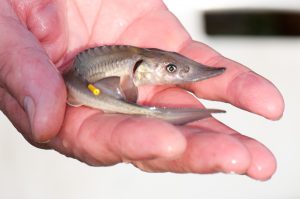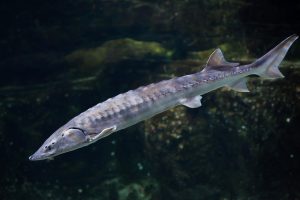The European sturgeon was once widespread in most large rivers across Europe and Great Britain but is sadly Critically Endangered today. Now, thanks to the first ever sturgeon re-introduction projects in France and Germany, they have started appearing once again off the south coast of England, most recently a sturgeon was caught off the Southwest coast earlier this month.
Historic overfishing, river barriers and pollution all contributed to the sturgeon’s decline, and the last recorded fish in our rivers was in the Tywi (Afon Tywi), Carmarthenshire in 1993.

Photo credit: Philip Freudenberg.
The UK Sturgeon Alliance is attempting to reverse this catastrophic decline and restore European sturgeon back to British waters. The ‘Save the Sturgeon’ website aims to raise awareness and allows users to log records if they have spotted the rare species. This valuable information will be fed directly into Great Britain’s sturgeon database, which will help the UK Sturgeon Alliance [ZSL, Blue Marine, IFM, Severn Rivers Trust] understand the current and historic presence of the species in our waters.

Photo credit: Shutterstock.
These remarkable migratory fish can reach six metres long and live for over 100 years. They return to rivers in the summer months to spawn before disappearing back to sea to continue their growth, feeding on bottom-dwelling species like worms and mussels.
Alex Hubberstey, project co-ordinator from the Blue Marine Foundation, said “sturgeon have survived multiple mass extinctions, but humans have driven these extraordinary fish to the brink of a total disappearance. My hope is that sturgeon will once again be a regular sight in our rivers and coasts.”
Steve Colclough, from the Institute of Fisheries Management, said “With the help of many interested partners, the Alliance has recently developed an incredible history of the sturgeon in England, Wales, and Scotland since 1700, through newspaper reports and museum exhibits. This database together with other historical and archaeological information shows clearly that sturgeon have been associated with our rivers, estuaries and coastal waters as far back as records extend. As the fish return, modern reports from fishermen, anglers and members of the public are becoming a vital element in developing our understanding and shaping our future work”.
Alison Debney, from ZSL, said “sturgeon are ancient fish which are an irreplaceable part of our world’s biodiversity. If we lose these unique fish, we lose hundreds of millions of years of evolutionary history.”
Ashley Deane, from Severn Rivers Trust, said “Through our catchment-wide conservation delivery we’re committed to continuing our development of river restoration projects to enhance the River Severn and its constituent tributaries for freshwater wildlife, particularly migratory fish species. We’re proud to be at the forefront of delivery across the Severn working with a vast range of partners, stakeholders and funders to bolster our aspirations of creating a thriving River Severn. Ensuring the future resilience of the catchment for the Critically Endangered sturgeon is imperative for the survival of this species.”
Find out more about sturgeon – or record your sighting – at www.savethesturgeon.com, or search #SaveTheSturgeon on social media.
Film: Animation showcasing the lifecycle of European sturgeon (A. sturio). Credit: Leapfrog Animation.
Find out more about Blue Marine UK Sturgeon project work here.
Cover photo credit: Pymoor Cambridge Community Archive Network.


















